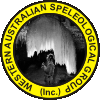BY. Rauleigh J. Webb, Past ASF CO-CONVENOR OF THE CONSERVATION COMMISSION
INTRODUCTION
Caves are an uncommon geological resource and the minerals that are deposited therein may be rare and occur in unique forms of great beauty which are irreplaceable if destroyed. Also irreplaceable are the archeological resources in caves which are of great scientific and historic value. It is further found that the organisms which live in caves are unusual and of limited numbers; that many are rare and endangered species; and that caves are a natural conduit for groundwater flow and are highly subject to water pollution, thus having far-reaching effects transcending man's property boundaries. It is therefore declared to be the policy and the intent of this legislation to protect these unique and cultural resources.
DEFINITIONS
(A) "Cave" means any naturally occurring void, cavity, recess, or system of interconnecting passages beneath the surface of the earth or within a cliff or ledge including natural subsurface water and drainage systems, but not including any mine, tunnel, aqueduct, or other manmade excavation, which is large enough to permit a person to enter. The word "cave" includes or is synonymous with cavern, sinkhole, natural pit, grotto, and rock shelter.
(B) "Show Cave" means any cave utilized by the owner for the purposes of exhibition to the general public as a profit or nonprofit enterprise, wherein a fee is collected for entry.
(C) "Gate" means any structure or device located to limit or prohibit access or entry to any cave.
(D) "Sinkhole" means a closed topographic depression or basin, generally draining underground, including but not restricted to, a doline, uvala, blind valley, or sink.
(E) "Person" or "persons" means any individual, partnership, firm, association , trust, or corporation or other legal entity,
(F) "Owner" means a person who owns title to land where a cave is located, including a person who owns title to a leasehold estate in such land, and specifically including the State and any of its agencies, departments, boards, bureaus, commissions, of authorities, as well as counties, municipalities, and other political subdivisions of the State.
(G) "Speleothem" means a natural mineral formation or deposit occurring in a cave. This includes or is synonymous with stalagmites, stalactites, helictites, anthodites, shawls, oolites (cave pearls), cave coral, columns, flowstone, gypsum flowers and needles. Speleothems. are commonly composed of calcite, gypsum, halite, epsomite, aragonite, celestite, and other similar minerals.
(H) "Speleogen" means an erosional feature of the cave boundary and includes or is synonymous with anastomoses, scallops, rills, flutes, spongework, and pendants.
(I) "Material" means all or part of any archeological, paleontological, biological, or historical items including any human remains, aboriginal artifacts or camp sites.[Refer to any legislation covering the protection of Aboriginal sites.]
(J) "Cave Life" means any life form which normally occurs in, uses, visits, or inhabits any cave or subterranean water system, excepting those animals and species which are classed as feral animals in Australia.
Section 1.1
(A) A person may not, willfully or knowingly:
(1) break, break-off, crack, carve upon, write, burn, or otherwise mark upon, remove, or in any manner destroy, disturb, deface, mar, or harm the surfaces of any cave or any natural material which may be found therein whether attached or broken, including speleothems, speleogens and sedimentary deposits
(2) disturb or alter in any manner the natural condition of any cave:[i.e. they may walk in caves but not disfigure them by, for example, digging a hole in the floor.]
(3) break, force, tamper with, or otherwise disturb a lock, gate, door, or other obstruction designed to control or prevent access to any, cave, even though entrance thereto may not be gained.
(4) however, the entering or remaining in a cave by itself shall not constitute a violation of this section.
Section 1.2
A person may not dispose of, dump, store, or otherwise introduce into any cave, sinkhole, or subterranean drainage system any litter, refuse, dead animals, sewage, garbage, or any chemical or biological contaminant which is potentially dangerous to man or any form of cave life. It shall also be unlawful to burn within a cave or sinkhole any material which produces any smoke or gas which is harmful to any naturally occurring organism in any cave.
[Provision for a penalty]
Section 1.3
A person may not sell or offer for sale any speleothems in this State, or to export them for sale outside the State. [Provision for a penalty]
Section 1.4
(A) A person may not remove, disfigure, kill, harm, disturb, keep, restrain, or in any manner alter the natural condition or any environment of any cave life.
(B) notwithstanding the provision of subsection (A) of this section, scientific collection permits may be obtained from the relevant Land Management Authority or owner.
(C) Gates employed at the entrance or at any point within any cave shall be of open construction to allow free and unimpeded passage of air, water, insects, bats, and aquatic fauna.
(D) If a natural entrance is altered by man or a man made entrance to a cave is created then it should be ensured that the original airflow and access of life forms, to the cave, is maintained.
(E) If any tourist development is to take place in any cave then the relevant management authority shall undertake an Environmental Impact Study prior to any works taking place.
(F) Prior to any development of any cave for tourism a Cave Management Plan shall be undertaken by the relevant management authority.
(G) [Provision for a penalty]
Section 1.5
(A) Archeology reference to the appropriate acts and if necessary specific clauses should be added to this piece of legislation if they are not encompassed in other acts.
Section 1.6
(A) Neither the owner of a cave nor his authorised agents acting within the scope of their authority are liable for injuries sustained by any person using the cave for recreational or scientific purposes if no charge has been made for the use of the cave, notwithstanding that an inquiry as to the experience or expertise of the individual seeking consent may have been made.
[Possible penalties:
Section on Speleothem Breakage - Minimum fine of $10,000 or 6 months in prison.
The other sections also require minimum penalties such as the one above for the section on Speleothem Breakage.]
To make comment on this draft legislation please email

